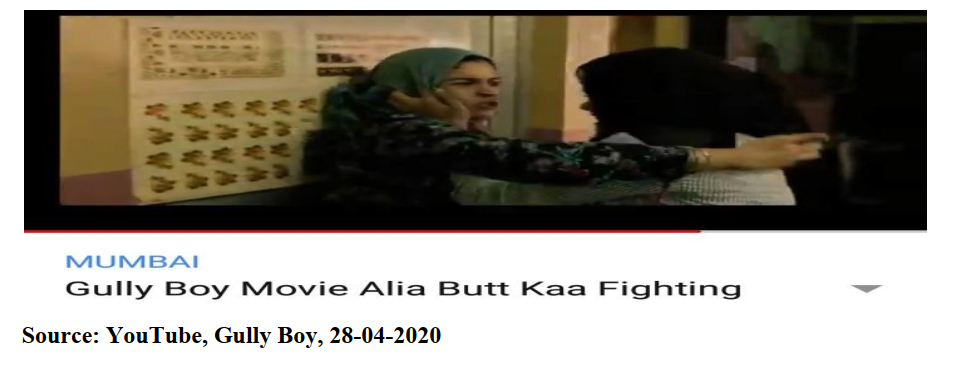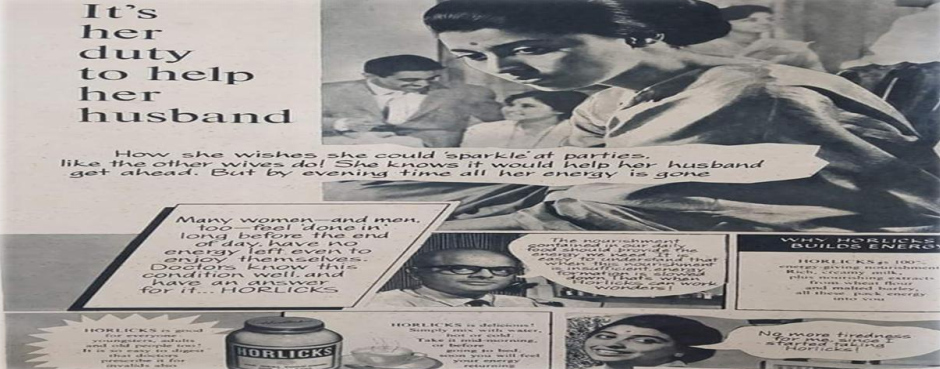Media plays a decisive role in the everyday life of youngsters not only because it conveys important facts and information but also because it is one the most important agencies of socialization and Gender Socialization. Media through its means of entertainment industry helps in the cultural upbringing of both men and women.
1.Depiction of men and women in Advertisements:
“Advertising is one of the major media that affect our daily life consciously and unconsciously and are responsible to play a significant role in shaping the society in a much broader perspective” (Mishra, 2015: 126).
Advertisements have mostly portrayed the binary categories of gender in traditional gender roles based on gender division of labour. It has helped to uphold and reinforce the patriarchal ideology inherent in Indian society. In one of the advertisement of Horlicks, the female protagonist is shown to uphold and practice the patriarchal ideal of domestic servitude. In order to maintain the socially constructed stereotypical role, she consumes the health drink which would help her to sustain the patriarchal ideology prevalent in Indian families.
2. Commodification of women in Indian movies:
Commodification is the process whereby an object/ human body loses its intrinsic value and becomes a market value to be used, bought and sold in the market for profit. Historically, men and women have been depicted in media in stereotypical gender roles which has facilitated and promoted gender division of labour in society. The way women and their
bodies were and are still projected obnoxiously through media mainly leads to the commodification where women’s bodies are treated as objects of sexual pleasure to titillate male desire and to promote ‘male gaze’.

Source: https://bollywoodjournalist.com/2013/08/23/dear-bollywood-stop-making-thosecrappy-item-numbers-first/, Google, 28-04-2020
Indian cinema is one of the major means of portrayal of Indian culture even in contemporary society. The changing scenario of modern India has been framed, shaped and expressed through Indian cinema. Due to the profound impact of Western neo-colonialism, even the racist ideals of women and femininity of western culture were expressed through Indian movies.
3.Valourization of socially constructed representation of men and women:
However, Indian media has also depicted domestic abuse for gender sensitization of the audience and have equally portrayed how women are treated as slaves to serve the male patriarch of their family. This conveys that women are projected in roles of domestic servitude which has reinforced the prevalence of patriarchal ideology and gender based
violence in movies (Movie Courtesy: Lajja).
Source: YouTube, Lajja Movie, 28-04-2020
Though the depiction of women in contemporary Indian movies has been progressive due to the improved status of women and feminist movement, yet issues of Toxic Femininity is being portrayed in movies like Gully Boy. Toxic Femininity motivates acceptance of aggression and domination silently which is highly valourized in society in the name of feminism.
 While on one hand, media’s depiction of women and their obnoxious representation of their bodies has been rampant, issues of men and masculinity are also being projected through Indian media where socially constructed images of masculinity has been valourized in Indian
While on one hand, media’s depiction of women and their obnoxious representation of their bodies has been rampant, issues of men and masculinity are also being projected through Indian media where socially constructed images of masculinity has been valourized in Indian
movies like Pyar Toh Hona Hi Tha. In one of the movie scenes, the male protagonist Ajay Devgan had to face humiliation and embarrassment from his family members due to the cutting of his moustache by the barber—- moustache being a socially constructed sign of „asli mard‟ or „macho man‟ has been valorized in Indian cinema.
Source: YouTube, Gully Boy, 28-04-2020
Moreover, media has mostly portrayed and continues to portray both men and women in socially constructed roles of masculinity and femininity which is socially acceptable by the audience. However, with the impact of feminist movement and empowerment of women, there has been rapid transformation in the projection of binary categories of gender with more
emphasis on Gender Inclusion (including Third Gender). Nevertheless, the objectification of women in media still continues to prevail and will prevail as long as patriarchy is not uprooted from where it has originated!
Visited 3143 times, 3 Visits today





